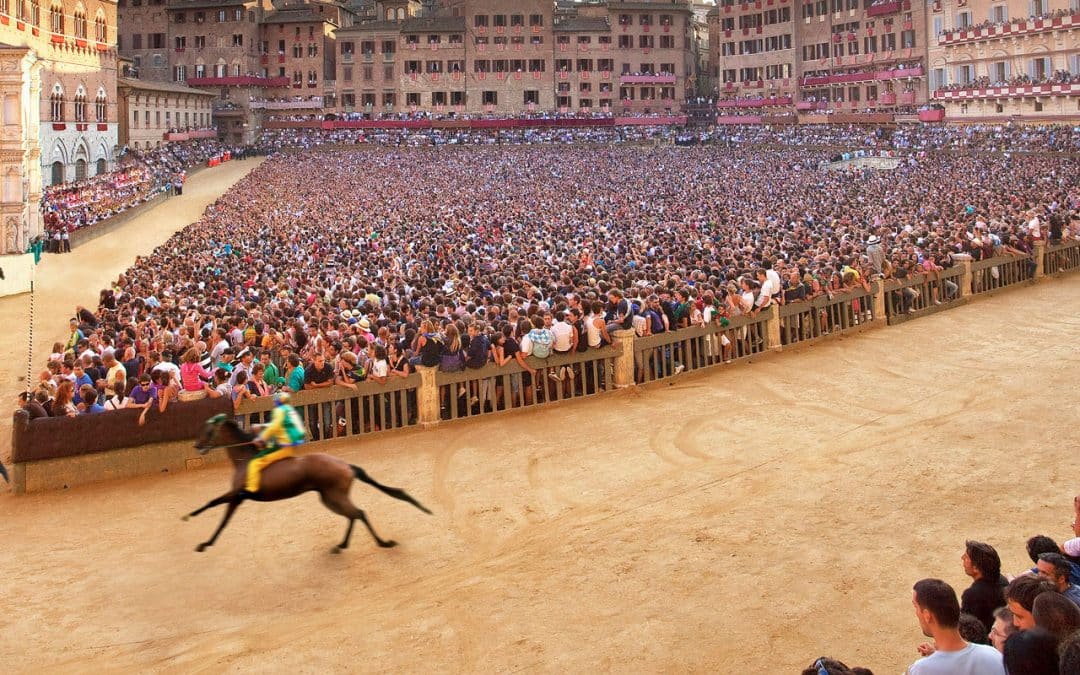What is the Siena Palio?
ll Palio di Siena: you will actually hear the word “palio” bantered around quite a bit in Tuscany, especially when Siena is in the mix.
Really? Who hasn’t heard of the Siena Palio?
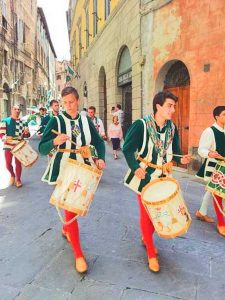
Historic parades in antique dress makes its way through the streets of Siena :: Bike Florence & Tuscany
event In general, a palio is a folkloristic that normally includes a mule, a donkey or a horse running laps with a colorful jockey urging them on. And this would be true, to a certain extent. However, when you use the word Palio it should also render the passion and soul of a rion or contrada (these are district within a city) who compete vigorously for a grand prize.
In the case of Siena it is called “Drappellone”, and it a piece of cloth which every year is commissioned to local and international artists. The end result is a rather spectacular “standard” with an image of the Madonna (Blessed Virgin Mary).
The emotion that these traditional medieval games evoke is quite indescribable; setting cousins against cousins, husbands against wives, BBFs against BBFs….though one would venture to say that friendship between two rival teams (rioni or contrade) is frowned upon in many towns.
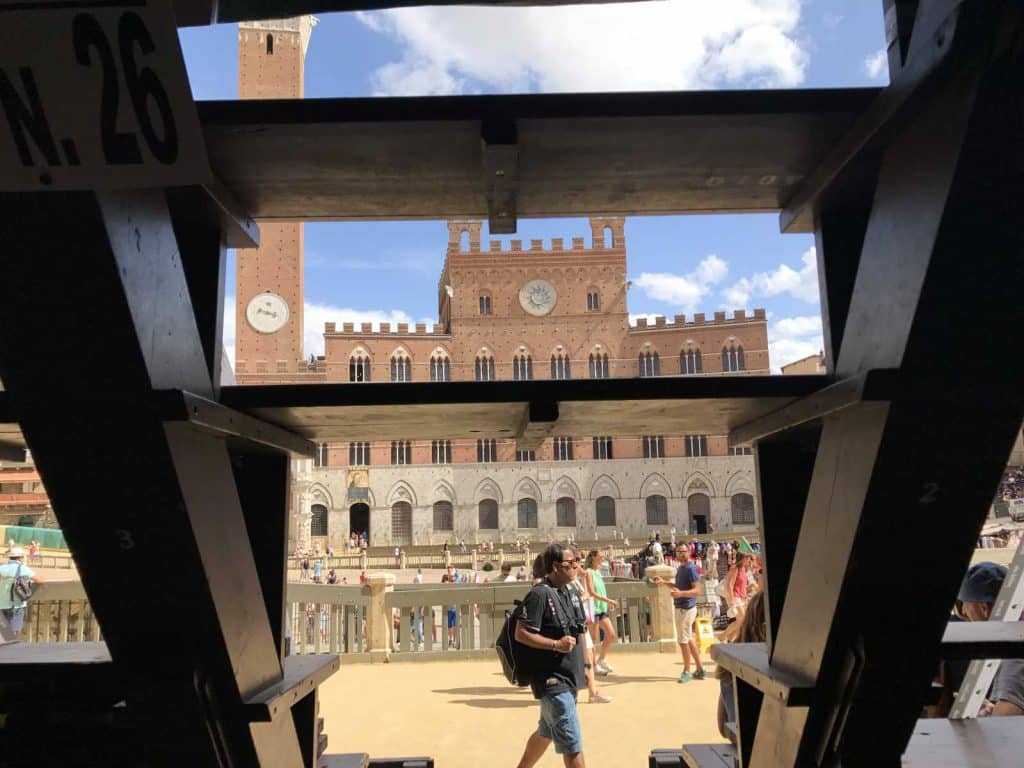
Il Campo as seen through the bleachers set up for the Siena Palio race :: Bike Florence & Tuscany
These emotions are golden threads that weave into the community and bind them together; supporting one another, their jockey and their horse with unbridled abandon and … well sometimes it looks like “mania”.
What is special about August Palio?
Siena holds two official palio races during the course of the year. The first has been traditionally held on the 2nd of July, every year. Tradition tells us that the palio held on the 16th of August was added as “an extra” event, by a special request made by the contrada called Oca to the Grand Duke himself. They so wanted to continue celebrating their win in July at the Palio Provenzano in the year 1701, that they petitioned the Grand Duke to hold another on the 16th of August, at their own expense! During the course of the following years, the government appropriated small amounts of funding for the event, however, they finally said no more.*
But that didn’t stop the townspeople who pawned personal items to pay for the expense of holding the palio!
It slowly became incorporated into the traditions of Siena, even though the local government insisted that it was an “exceptional event”. Towards the end of the 1700s, it became clear to the authorities that if they didn’t start to intervene, that the integrity of the event would be out of their control. The government of Siena began to petition the authorities in Florence for permission to officially organize and fund the event.
After a bit of political jockeying, in 1802, the regional government recognized two dates for the Palio di Siena: one on the 2nd of July and one on the 16th of August, also called il Palio dell’Assunta.
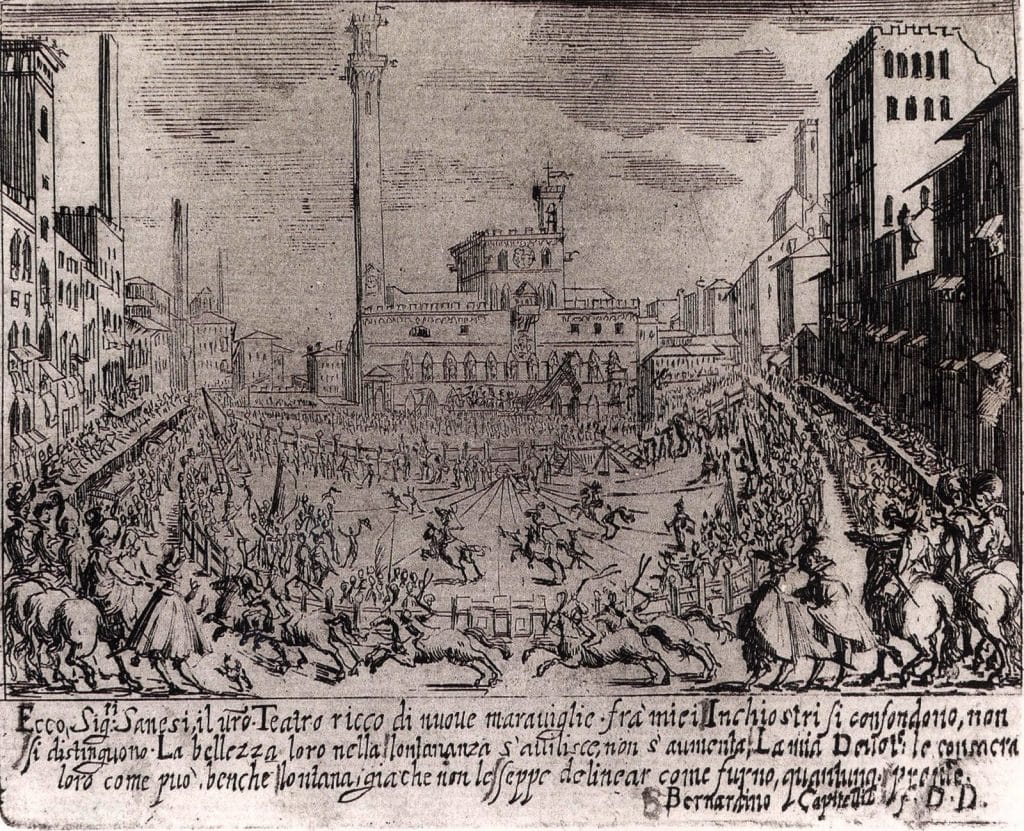
Historical design of the Siena Palio :: Bike Florence & Tuscany
5 Fun Facts about Siena Palio
A festival as strongly felt like that of the Siena Palio brings with it many intriguing and curious tidbits of information:
1. Siena Palio : Bullfighting
From the XV century to the year 1597 Siena held “Caccia dei Tori” (bull hunting) exhibitions in the main square. The show would start with a parade of the participating contradas, followed by the entrance of various animals ranging from hares, porcupines, and foxes to animals as big as deer and wild boar. The last animal to enter into the square were the bulls. This type of event was eventually suppressed in 1597, only to be substituted with the racing of the bulls or the Bufalata.
In this case, each contrada would have a bull and a jockey and a group of “instigators” who were authorized to push and prod their bull to the finish line…appears they also had carte blanche to slow down the competition with their pointy poles.
2. Siena Palio : the second is the looser
On the Siena Palio The desire to be the first is felt very deeply in the contradas; jockeys want to win because only the first place is honored. Not only is the second horse & contrada considered the loser, but they have also to deal with the stigma of public shame, called “purga” in Italian.
Other than tugging on an opponent’s reins, jockeys are allowed to do anything to distract other jockeys during the race – in some cases, they will actually fall off their horses! Which is probably why the rules state that you win even if just your horse crosses the finish line first.
Documented cases show that the rivalries are so intense that people of a contrada do anything to win, and prevent the victory of their enemies! In some cases, a nonparticipating contrada will create a diversion to hinder the rivals or help the allies. For example, bribing a jockey?
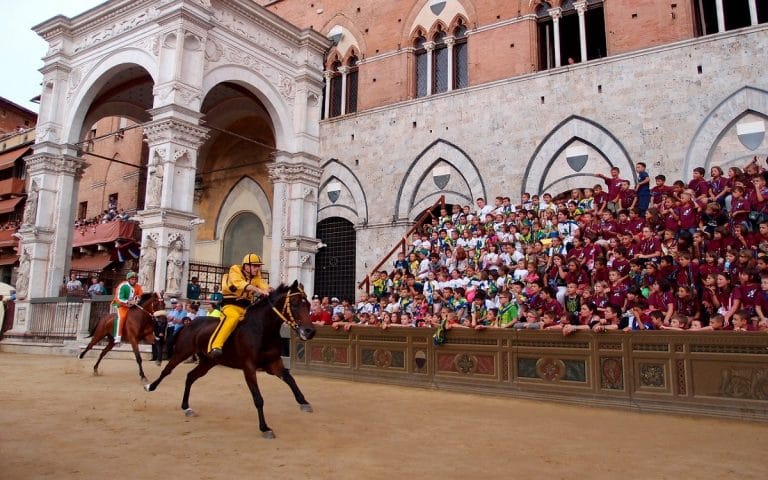
In front of the Torre di Mangia in the Piazza il Campo for the Siena Palio :: Bike Florence & Tuscany
3. Siena Palio : Nonna _ vocabulary _
The Siena Palio has created a vocabulary all of its own and perhaps one of the more peculiar terms is the word “nonna” which means grandmother in Italian. The contrada which goes the longest amount of time without winning holds the nickname “nonna” and symbolically wears the “cuffia” or kerchief. At the moment that they finally win, they are “scuffiata”, in other words, lose the grandmother’s kerchief.
4. Siena Palio, Contrada & Baptism
The contrada you belong is a matter of pride. But how does it happen?
Well, you are a member by birthright. Or by bloodline. Or through the contradaiolo baptism.
Actually, the baptism is a rather recent event, since WWII. This form of membership was introduced due to the displacement of the population from the historic center to the periphery. This meant babies were born in hospitals outside the city walls and therefore outside the territory of any contrada.
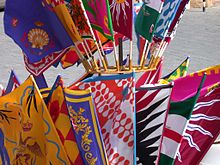
There are 17 contrade that can race in the Siena Palio :: Bike Florence & Tuscany
At one time everyone was born in houses which were positioned within the contrada borders.
When someone lived outside of their borders, extreme measures where taken: the woman was brought to give birth in the house of friends or relatives residing in the appropriate contrada or dirt from that contrada was gathered and spread under the bed where she was to give birth.
Today, with the annual baptism of new entries in each contrada, you can be born anywhere.
In preparation of the Siena Palio they are held on the day of the patron saint of the district, where a child’s forehead is touched with the water from the contrada baptismal font of the contrada.
5. Siena Palio : Getting to Siena during these days
If all of this has you enthusiastic to see the Palio di Siena or if all this tradition has you curious to visit Siena, then we have one last fun fact for you – the palio events actually last 4 days!
So you have more than one opportunity to make it and see a part of the preparations of the Siena Palio if not the big 90 second race itself.
Bike Florence and Tuscany has two tours that end in Siena, giving you time to explore the labyrinth of streets, admire the churches and the monuments and visit the square of Siena where the palio is held.
Piero & Elena drop you off in front of the Basilico di San Domenico and give you a map of the town pointing out not only their favorite restaurants but also the many sites you can visit.
The San Gimignano to Siena bike tour is a family-friendly biking adventure offering you free time in San Gimignano before pedaling the via Francigena and low trafficked backroads towards the fortress town of Monteriggioni. At the end of the bike tour, you discover Siena and its medieval city center.
Or you could opt for the Crossing Chianti to Siena tour which includes leisurely panoramic biking among vineyards, hills & small towns like that of San Donato in Poggio and Castellina in Chianti. An extra plus, there is a sommelier-guided wine & olive oil experience before ending in Siena for sightseeing & lunch on your own.
Be sure to book in advance, these tours fill-up fast!
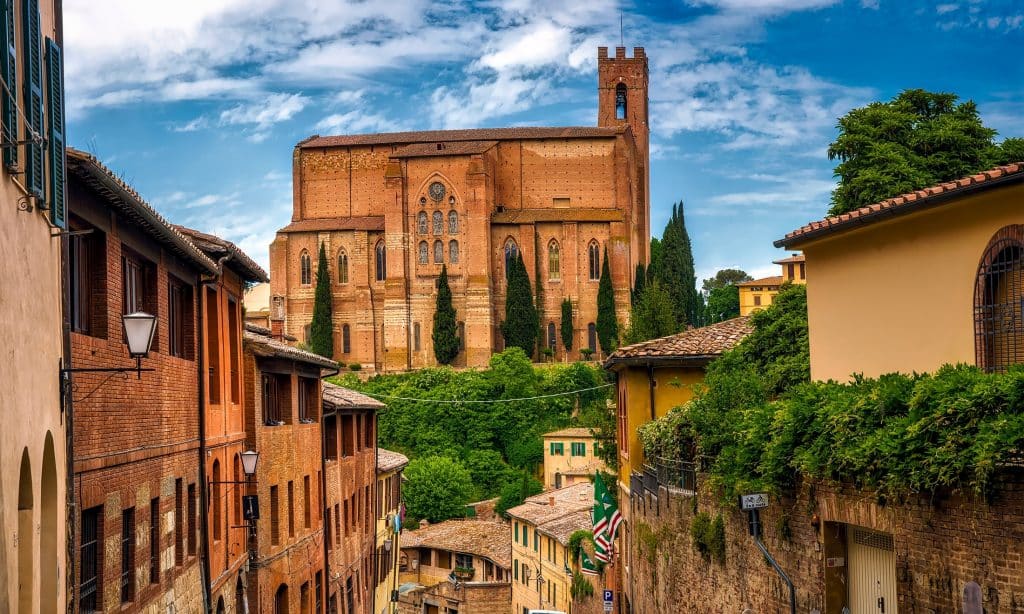
Basilica of San Domenico is your reference point for a bike tour with Bike Florence and Tuscany
*historical note found at this website

